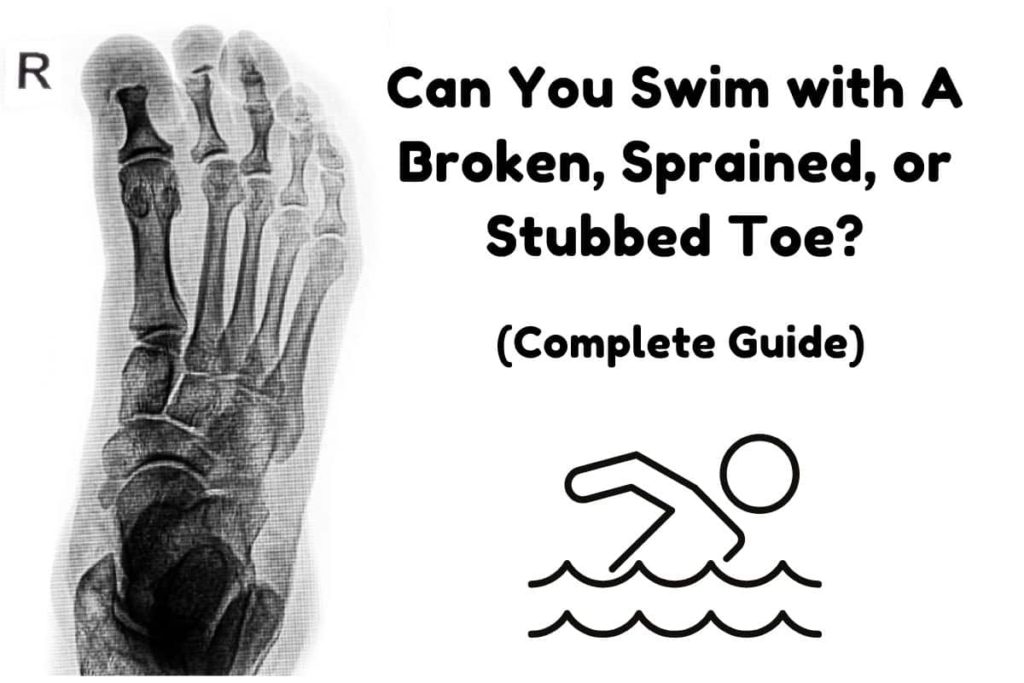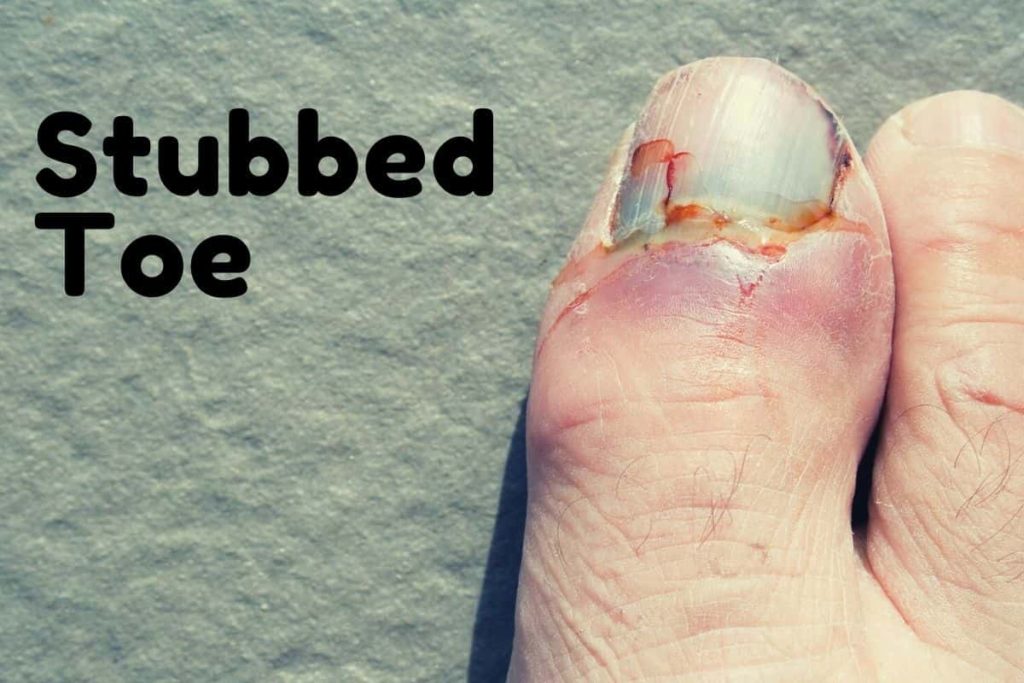There are 206 bones in the human body. Twenty-six of those bones are found in the foot (as well as 30 joints and 100+ muscles, tendons, & ligaments). Fourteen bones make up the toes (the small toes each have 3 bones and the big toe has 2). This means the bones of the foot account for just over one-fourth of all the bones in the human body.
Our feet provide us with support and movement. A broken (fractured) foot bone, including a toe, is often a painful nuisance. A broken toe, specifically, will rarely leave one unable to function. While a broken bone, particularly one of the foot- such as a toe, is never fun or ideal, it is bound to happen to most of us at some point in life (if it hasn’t already).
Once one has been cleared to return to physical activity (or sent to physical therapy) after sustaining a broken toe, they will want to avoid activities that require significant weight-bearing and/or are high-impact, especially concerning the toes. Thus, swimming is a great option. (Just be sure to ease into it as one does not want to prolong their current healing process/recovery or re-injure themself).

The reality is we put our feet through a lot daily. Our toes are at the front of the feet so they will typically take the brunt of any foot trauma. Thus, a broken toe (or other foot bone), at least once at some point in life, is pretty inevitable.
Symptoms of a broken toe (fractured toe bone) include,
- Throbbing pain (especially with walking)
- Swelling
- Bruising (skin and/or toenail)
- Inability to move the toe (either a limited range of motion-ROM- or not all)
- The toe appears crooked or deformed (disfigured)
- Tingling or numbness in the toe (sometimes a burning sensation)
As such, one may be wondering if they would still be able to swim with a broken toe.
The short answer is, Yes!
It is safe for one to swim with a broken toe (or, even fracture of the forefoot). But, it does, ultimately, depend on the exact nature and extent of one’s injury. There are some contraindications (i.e., reasons one should not swim) for swimming with a fracture (broken bone).
For example, one is generally able to continue swimming safely with a broken toe provided necessary precautions are taken (i.e., the injured toe is “buddy taped”). However, if one has sustained a more severe fracture such as a compound fracture, or multiple fractures in the foot, the recovery process may require complete rest initially (and, thereby, swimming would be contraindicated).
When in doubt, check with your physician or a licensed medical professional to see if it’s okay to continue (or, return to) swimming before getting back in the water.
Whether or not one can swim with a broken bone depends on which bone is broken and how bad of a break was sustained.
Foot injuries, especially broken bones in the feet, such as a broken toe, tend to take longer to heal. Some fractures can take months to heal. The severity of the fracture as well as the location within the foot will dictate exactly how long the [typical] healing process is. Here’s a look at some of the common foot injuries and their healing times
- A broken bone in the forefoot or Severe fracture type such as a compound fracture: 6-8 weeks
- Broken Toe: 4-6 weeks
- Stress Fracture: 3-4 weeks
- Sprained Toe: 3-7 days (up to 1 week)
There was a day when the prescription (recommendation) for broken bones included lengthy rest periods to allow the re-set bones necessary time to heal (i.e., fuse back together) before physical therapy/activity was (re)introduced. Today, R.I.C.E.- Rest.Ice.Compression.
Elevation.- is still [generally] the first thing prescribed for a foot injury, particularly a broken toe. However, nowadays, physical therapy (i.e., physical activity) is being prescribed sooner versus later for [bone] injuries- including a broken toe.
Introducing physical therapy (getting back to physical activity) sooner versus later helps to prevent muscle atrophy. Preventing muscle atrophy will ultimately help keep bones in place (where they belong). It’s also one of the best ways to strengthen bones.
When swimming with a broken toe (or, once you’ve been cleared to swim after such an injury), one will want to assure adequate support for the injured toe to not further injure it while swimming. The best way to do this is by taping the broken (injured) toe to the [uninjured] toe next to it (i.e., “buddy taping”). Also, pass on flip turns or other activities that require pushing with the feet/toes or that are weight-bearing- one doesn’t want to put too much pressure on the injured foot/broken toe.
On a side note, check out How Do Swimmers Know When To Turn & When To Stop?
With precautions in place and easing into it, one can [safely] swim with a broken toe.
(Source A)(Source B)(Source C)
Is Swimming Good for Broken Bones?
Swimming is one of the most popular activities in the US- both, for leisure and sport. As one probably knows by now, swimming has a plethora of benefits (and very few adverse effects)- particularly to one’s physical and mental health/well-being. As such, water therapy (sometimes called aqua therapy), including activities like swimming and water/aqua aerobics, is often prescribed (recommended) as part of one’s rehab (therapy) post-injury (or illness).
We do recommend that you check out our post titled ” Why is Swimming and/or Hydrotherapy Often a Popular Choice for Physical Therapy?“
Some of the water’s many benefits concern healing. Water’s inherent properties (its very nature) help bones and joints in several ways-particularly when it comes to healing. Some of those ways include
- Water’s resistance helps to build muscle strength [when exercising in water]
- Water’s resistance also provides reduced pain and ease of movement
- Water’s buoyancy reduces impact and stress while supporting muscles and joints (this makes for low-impact, non-weight-bearing exercise, and aids injury recovery)
- Water’s hydrostatic property causes water to press on injured areas (i.e., creates compression) which will reduce swelling. Reduced swelling will yield improved motion/range of motion
- Decreased pain due to the relaxing effect of warm water (as well as being submerged in water)
- The water can create a heightened sense of body position and thus, help improve balance
- With a decrease in pain and an increase in balance, many can move more freely. This freedom of movement reduces fear and anxiety concerning the injury which, in turn, has a positive effect on one’s overall recovery
- Swimming is active stretching. This keeps the muscles loose and limber (i.e., mobile) which is important in the rehab process. (bonus it stretches the entire body)
- A few studies have shown that swimming may promote nerve regeneration which speeds the healing process
That said, one can reasonably deduce that swimming is good for broken bones (though not while in a cast or other non-water-friendly (i.e., not waterproof) stabilizing device).
Swimming (water/aqua therapy) not only helps one recover from injury/illness such as a broken bone (or soft tissue/joint injury such as sprains, strains, tears) but can also help reduce the pain that results from several situations (the most common being back pain). Because of water’s inherent properties and its ability to aid the healing process, The American College of Sports Medicine (ACSM) recommends swimming or walking in the water as one of four preferred rehab exercises for soft tissue injuries(i.e., sprains/strains/tears to ligaments/muscles/tendons.).
Though the ACSM’s recommendation is concerning soft tissue injuries versus bones, this indirectly [positively] affects one’s bones as ligaments, muscles, and tendons help to hold bones in place as well as offer them some protection. As such, the stronger one’s soft tissues are, the healthier their bones are (most likely, at least, there are always exceptions).
A fracture to the foot, particularly a toe, can be very painful. The recovery process can also be painful and cumbersome- especially if there is a cast and/or walking boot involved. Thus, once one is cleared for physical activity- namely, swimming- getting back to one’s pre-injury strength will take more than just sliding in the water and swimming laps. You’ll need to “wake up” the muscles utilized in the different strokes, particularly those used in kicking, and pushing off the wall (i.e., the muscles of the foot).
Some ways to reawaken the muscles of the lower body, particularly the foot, and prepare them for swimming, particularly the push off the wall and kicking, including
- Heel Raises/Tip-Toes: While standing in the water, lift [up] onto your toes. (as if tip-toeing, and, thus, raising your heels.)
- Jump Squats: Stand in water that is at a depth just under the breast line/at the top of the ribs (between your navel and neck), bend your knees (do not let the water go past your neck/do not fully submerge), and jump with both feet
Though swimming has been shown to have a positive effect on the rehab of broken bones, one will want to incorporate land-/gym-based exercises into their rehab training as well.
Some ideal, low to non-weight-bearing, activities to incorporate with swimming include cycling/stationary bike, elliptical, rowing, yoga, and other exercises that can be done while seated or lying down (i.e., bearing minimal weight)
Of course, swimming is not suitable as a means of rehab/recovery for all injuries. While most often swimming is helpful to the rehab and recovery of broken bones, there are some instances in which it may not be advised for one to swim immediately after an injury (but, once one is cleared for physical activity/exercise, swimming is often the best place to begin).
Thus, if one has suffered an injury, particularly a broken bone, it is important that they talk to their doctor, or a licensed medical professional, before continuing to swim, despite the injury, or resuming swimming post-injury.
If you require a specific (formal) rehab program, you’ll want to talk with your doctor for a referral to a physical therapist or reach out to a local physical therapist of your choosing. If the provider recommends swimming (water/aqua therapy) for your rehab and recovery, grab your swimsuit and towel, and ease your way back into it- you’ll be back in the swim of things in no time. (Source A)(Source B)(Source C)(Source D)
Can I Swim with A Stubbed Toe?
Much like a broken toe, a stubbed toe is extremely painful. One physician attributes this pain to nerve receptors being damaged when the toe is stubbed. Each toe has a nerve on either side. Thus, no matter how one stubs their toe they are likely to hit one of those nerves/nerve receptors.

A stubbed toe is an injury that results from jamming the toe against another object. It occurs suddenly and varies in severity. When you have stubbed your toe a few things that may (or may not) occur include
- Throbbing pain in the toe
- Swelling (toe and foot)
- Bruising and/or discoloration
- Subungual hematoma (bruising under the nail/of the nail that may result in bleeding from the nail bed)
- Difficulty (painful) walking
- Difficulty wearing socks/shoes comfortably
Recovery is dependent on the nature (severity) of the injury and, thus, it can vary. However, regardless of the nature (severity/extent) of the injury, a hard and fast rule of rehab/recovery is to follow the R.I.C.E. method (Rest.Ice.Compression.Elevation.).
Generally, a subbed toe shouldn’t keep one out of the water.
But it’s not just the toe that is affected when it is stubbed. Often, the skin and the nail are affected too and will need to be treated and monitored. The skin and the nail of the stubbed toe will be the deciding factor on whether or not one can swim with a stubbed toe.
If there is no visible abrasion or bleeding (i.e., open wound), one should be fine to swim. Just go easy and monitor the toe’s condition. If needed tape it to the adjacent toe for stability.
When there is an open wound (an abrasion and/or bleeding) you will want to avoid the water until the bleeding has stopped. Once the bleeding has stopped, until the wound is healed sufficiently, you’ll want to assure the toe is bandaged (covered) before getting in the water for a swim.
One can swim with a stubbed toe so long as it is a closed injury (i.e., there is no break in the skin or bleeding)
Can You Swim with Sprained Toes?
When you stub your toe on itself, such as when running around barefoot on grass or in the sand, it is known as “turf toe”. This is a sprain of the big toe joint. In other words, the ligaments (or muscles/tendons) of the big toe have been injured. Though a sprained toe is painful, it is still functional- one can continue with their normal, daily activities, but they may feel soreness/tenderness or pain with movement/weight-bearing.
Typically with a sprain the immediate pain subsides relatively quickly and changes to a dull pain/ache. Depending on the severity of the sprain it may take only a few days to one week to heal. Because swimming is low-impact and non-weight-bearing, one CAN swim with a sprained toe. (Just be sure to stop if you feel pain and avoid pushing off the wall [with your feet].)
What Exercise Can I Do with A Broken Toe?
Though we may do our best to protect our feet/toes, we still put them through a lot. As such, a broken toe is still a pretty common injury – whether it’s the result of stubbing it severely or dropping something on it (such as a weight at the gym).
Foot injuries, particularly broken toes, can be a real hindrance to exercise/physical activity. It can be challenging to exercise with a broken toe, but it is not impossible. As such, one may be curious as to what exercises they can do with a broken toe.
First and foremost, you will want to avoid exercises/activities that require excessive loading of the toes or high-impact to the feet until you are cleared to return to 100% ‘normal’ activity. Some exercises and/or physical activities that one can do with a broken toe include
- Rowing
- Elliptical
- Swimming (laps)
- Water/Aqua Aerobics (water fitness class)
- Walking (progress to running) in the pool
- Cycling
- Other Upper Body only workouts/exercises (i.e., allow you to minimize the amount of weight you bear on your injured foot)
Some specific rehab exercises that one can do to aid the rehab/recovery of a broken toe include
Passive Toe Exercise
- Sit on the floor. Place the heel of the injured foot on the floor. Use a hand to hold the foot steady.
- With the hand that is not steadying the foot, use the thumb and index finger to slowly bend your toe forward and then backward. Hold each position for about 15 seconds.
- Repeat 2 to 4 times.
Toe Curl
- Sit on the floor. Place the heel of the injured foot on the floor.
- Gently curl the toes forward and backward. Hold each position for approximately 6 seconds.
- Repeat 8 to 12 times.
Towel Scrunches
- Sit in a chair. Place a towel on the floor in front of the chair. Place the injured foot on the towel.
- Scrunch the towel toward you using the toes. Then, use the toes to push the towel back to its starting position.
- Repeat 8 to 12 times.
Marble Pick-Ups
- Place some marbles on the floor next to a cup.
- Sit in a chair. Use the toes of the injured foot to pick up and then, place the marbles in the cup, one at a time.
- Repeat 8 to 12 times.
Towel Stretch
- Sit with legs extended and knees straight.
- Place a towel, belt, or strap around the [injured] foot just under the toes. Hold the ends of the towel, belt, or strap so that your hands are above your knees.
- Pull back on the towel, belt, or strap so that the foot flexes (stretches) toward you. Hold the position for 15 to 30 seconds, at least.
- Repeat 2 to 4 times
Is Swimming Good for Building Bone?
A decrease in bone strength often originates from osteoporosis, a condition where bones become weak and more susceptible to breaks/injury (fracture) because of low bone density.
It is well known that swimming is a great low-impact non-weight-bearing activity that improves cardiovascular health while building muscle. While swimming may be great for one’s overall health/well-being, and, specifically, cardiovascular health and building muscle, with the increasing concern around bone health, one may be wondering if swimming is good for building bone(s)?
Though it has positive effects on one’s cardiovascular health and building muscle, swimming has no positive effect on bone mineral density (BMD). In other words, according to the National Institute of Health (NIH), swimming is not the best exercise for improving bone strength (i.e., building bone(s).
This can be explained by Wolff’s Law which states that “bone in a healthy animal will adapt to the loads under which it is placed”. Thus, if the load (amount of weight) placed on a particular bone increases, the bone will adapt to become stronger so that it can resist that sort of loading.
Because of water’s inherent properties, it provides an environment with hypogravity. As such, exercises performed in the water are non-weight-bearing and low-impact. Weight-bearing exercises are vital to the generation (building/development) of new bone.
Just as the application of stress on muscles leads to higher muscle mass (i.e., larger muscles), the stress placed on bones through weight-bearing exercise causes them to be higher in density. To be more precise, the stress from weight-bearing exercises stimulates the synthesis of osteoblasts- the “building blocks” of bones (i.e., the cells that make bones).
It is these facts that have led many to conclude that swimming has no benefits for bone(s)/bone health. After all, it isn’t providing the necessary stimulus that activates the process of increasing bone density (i.e., generating bone growth). However, to conclude that swimming has no benefits for bone(s)/bone health is inaccurate (premature), as it isn’t considering other known factors about bone health.
While swimming may not have the same benefits as weight-bearing exercise on bone health, it does still have positive effects on the quality of one’s bones.
This is shown in that swimming has been shown to increase bone turnover– a process that results in a stronger structure, and, thus, a stronger bone. In other words, increased bone turnover results in younger, stronger bones that are more flexible and less susceptible to breaking. (While swimming does increase bone turnover, it is important to note that it is not better at doing so than weight-bearing exercises.
In addition to stimulating bone turnover, swimming also builds muscle. An increase in muscle mass results in bone formation as a result of the passive stress that muscles/muscle mass place(s) on bones. This passive stress also stimulates the formation of osteoblasts- those cells that build bones.
In addition to helping build bones, muscles help prevent fractures. This is because muscle(s) help(s) improve balance, coordination, and flexibility.
So, ultimately, swimming does have some benefits for bone health, though, not concerning bone density, specifically. Thus, one does not need to give up swimming to improve bone health. Rather, continue swimming and compliment your swimming with weight-bearing activities such as speed-walking, jogging/running, climbing stairs, hiking, or lifting weights (just to name a few).
When one combines swimming and weight-bearing exercises they ultimately improve their overall health, not just their bone health. Check out our post Swim or Gym – Which Is Better? Should You Swim Before or After a Workout!

